The armed forces yesterday held a missile exercise in the south, substantially increasing the hit ratio from a similar drill in January last year with a 96 percent success rate.
In all, 26 missiles were fired from 12 platforms in the Joint Live Fire Exercise of the Armed Forces at the Chung-Shan Institute of Science and Technology (CSIST) missile test base in Jioupeng (九鵬), Pingtung County. Three services — the army, air force and navy — participated, with more than 2,300 soldiers mobilized for the exercise.
Things got off to a rather dispiriting start when the first two items on the agenda, the CSIST-developed Tien Kung II (TK-2) surface-to-air missile and a US-made ship-launched Standard Missile I (SM-1) surface-to-air missile, were canceled seconds before they were to be fired. Just over 15 minutes after successful intercepts by ground-launched Hawk and air-launched Tien Chien II (TC-2) and MICA missiles, a Hsiung Feng II (HF-2) anti-ship missile launch from a Lafayette-class frigate had to be canceled after a fishing vessel reportedly ventured into the naval exclusion zone.
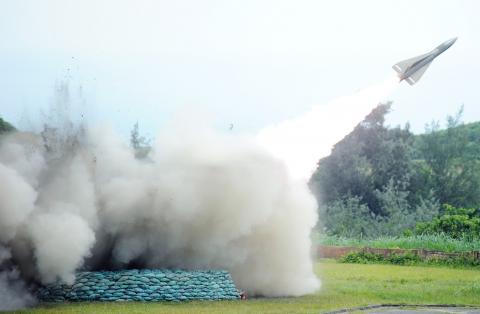
Photo: Sam Yeh, AFP
Minutes later, a short-range HF-1, launched off a Jin Chiang-class missile corvette, hit its target, a decommissioned transport ship located 9 nautical miles (16.6km) into the Taiwan Strait.
From then on, the rest of the exercise went smoothly, with F-16-launched AGM-65 “Maverick” and AIM-9 “Sidewinder” missiles, and a “Ching Kuo” Indigenous Defense Force-launched TC-1, all hitting their targets in mid-flight. A ground-to-air version of the TC-1 also intercepted its target, while two AIM-9s launched by AH-1W Cobra attack helicopters hit their objectives.
Journalists cheered when the military announced that the HF-2 and SM-1 launches would now proceed, as the fishing vessel had cleared the area. While the SM-1, launched off a Perry-class vessel, intercepted its target, the HF-2 failed to hit home, missing another decommissioned transport ship 33 nautical miles at sea — the only miss that day.
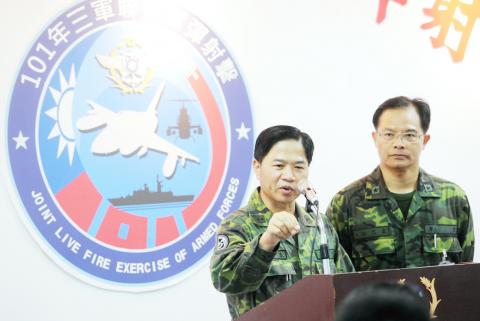
Photo: Lo Pei-der, Taipei Times
During a press conference following the exercise, Ministry of National Defense officials said they were “quite satisfied” with the results, which enjoyed a 96 percent hit ratio.
A malfunction during the launch of two UK-made Banshee drones accounted for the aborted launch of the TK-2, officials said.
Turning to the presence of a fishing vessel, the military said 19 navy ships had been out at sea to secure the area, adding that one ship was sent out to force the intruders away from the area. The ministry confirmed the fishing vessel was foreign, but did not give their country of origin.
However, an official said that if Chinese ships had been present — during exercises in the past, China sometimes relied on fishing vessels to gather intelligence — some types of missiles would not have been launched.
The US-made AIM-7 “Sparrow,” which malfunctioned and dropped into the sea immediately after being launched during last year’s exercise, was excluded this year. The ministry said the US was still investigating the cause of last year’s failure and added that the decision not to include it had also been made for safety considerations, given the advanced age of the missile.
A ship-launched CK-3 Banshee drone also experienced technical failure and fell in Pingtung City, blowing a small crater in a road, officials said.
President Ma Ying-jeou (馬英九), who had expressed dissatisfaction after attending last year’s exercise, which scored a 68.4 percent hit rate with six misses from 19 missiles launched, was not present yesterday.
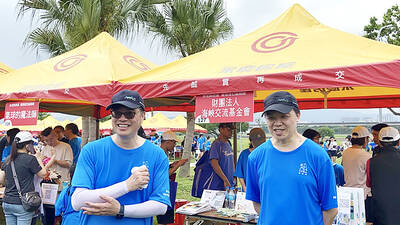
SECURITY: As China is ‘reshaping’ Hong Kong’s population, Taiwan must raise the eligibility threshold for applications from Hong Kongers, Chiu Chui-cheng said When Hong Kong and Macau citizens apply for residency in Taiwan, it would be under a new category that includes a “national security observation period,” Mainland Affairs Council (MAC) Minister Chiu Chui-cheng (邱垂正) said yesterday. President William Lai (賴清德) on March 13 announced 17 strategies to counter China’s aggression toward Taiwan, including incorporating national security considerations into the review process for residency applications from Hong Kong and Macau citizens. The situation in Hong Kong is constantly changing, Chiu said to media yesterday on the sidelines of the Taipei Technology Run hosted by the Taipei Neihu Technology Park Development Association. With
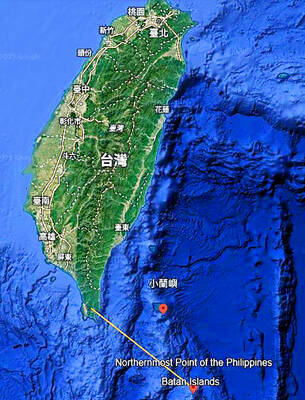
A US Marine Corps regiment equipped with Naval Strike Missiles (NSM) is set to participate in the upcoming Balikatan 25 exercise in the Luzon Strait, marking the system’s first-ever deployment in the Philippines. US and Philippine officials have separately confirmed that the Navy Marine Expeditionary Ship Interdiction System (NMESIS) — the mobile launch platform for the Naval Strike Missile — would take part in the joint exercise. The missiles are being deployed to “a strategic first island chain chokepoint” in the waters between Taiwan proper and the Philippines, US-based Naval News reported. “The Luzon Strait and Bashi Channel represent a critical access
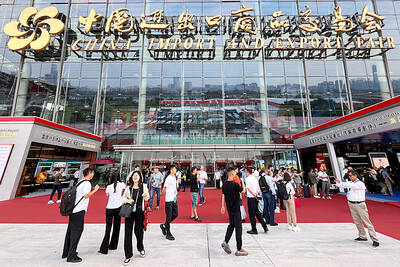
CARROT AND STICK: While unrelenting in its military threats, China attracted nearly 40,000 Taiwanese to over 400 business events last year Nearly 40,000 Taiwanese last year joined industry events in China, such as conferences and trade fairs, supported by the Chinese government, a study showed yesterday, as Beijing ramps up a charm offensive toward Taipei alongside military pressure. China has long taken a carrot-and-stick approach to Taiwan, threatening it with the prospect of military action while reaching out to those it believes are amenable to Beijing’s point of view. Taiwanese security officials are wary of what they see as Beijing’s influence campaigns to sway public opinion after Taipei and Beijing gradually resumed travel links halted by the COVID-19 pandemic, but the scale of
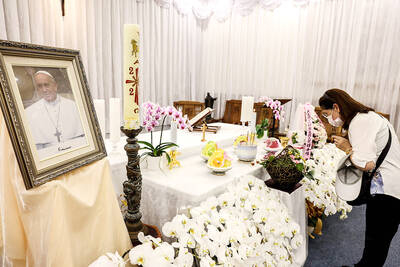
Pope Francis is be laid to rest on Saturday after lying in state for three days in St Peter’s Basilica, where the faithful are expected to flock to pay their respects to history’s first Latin American pontiff. The cardinals met yesterday in the Vatican’s synod hall to chart the next steps before a conclave begins to choose Francis’ successor, as condolences poured in from around the world. According to current norms, the conclave must begin between May 5 and 10. The cardinals set the funeral for Saturday at 10am in St Peter’s Square, to be celebrated by the dean of the College